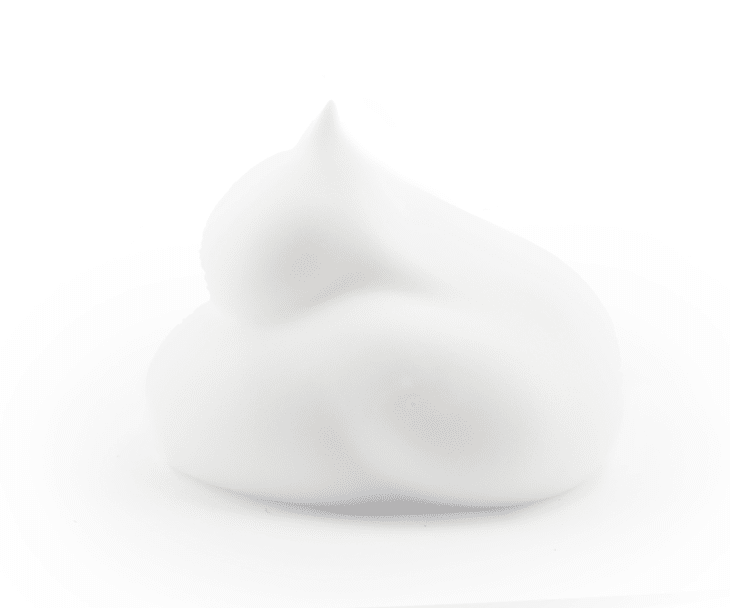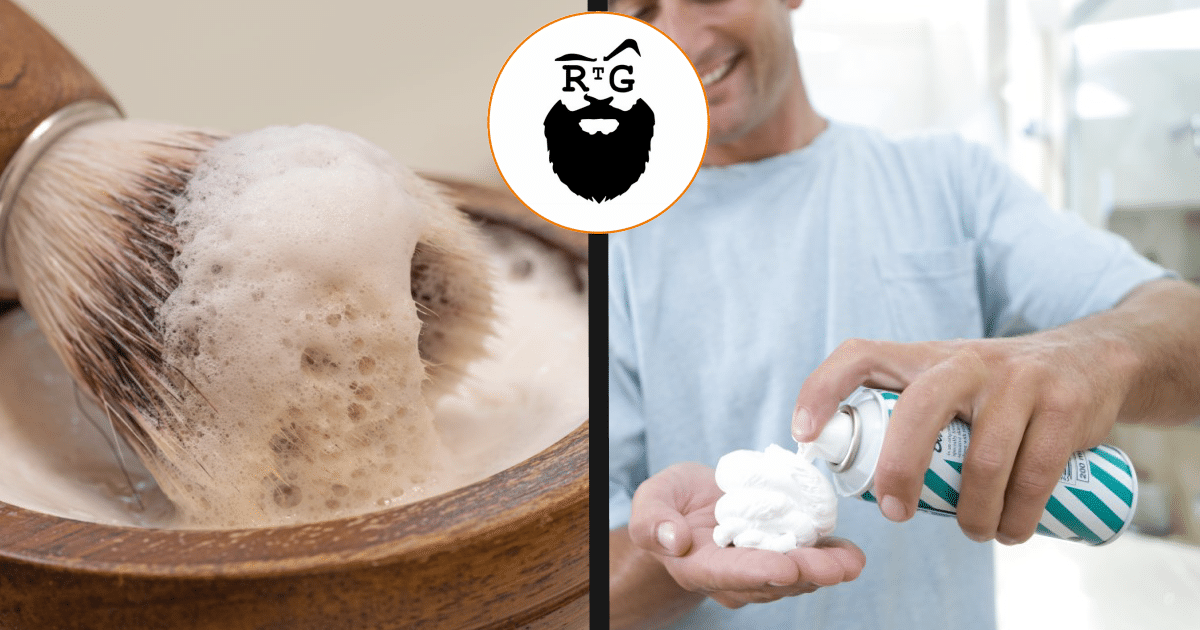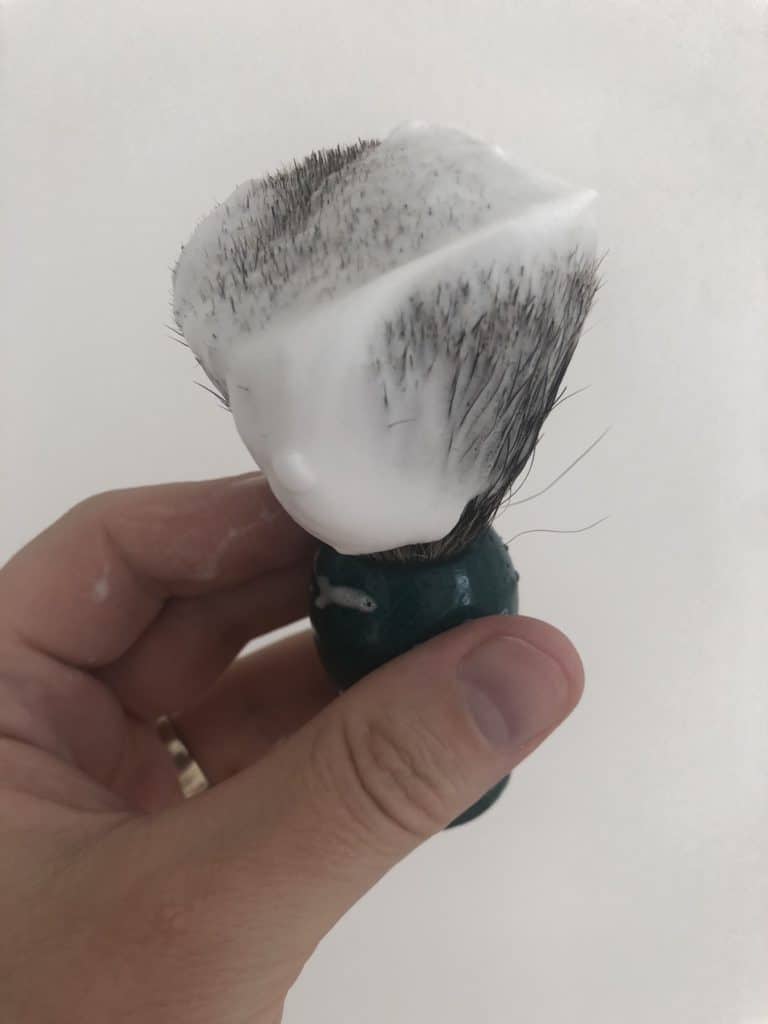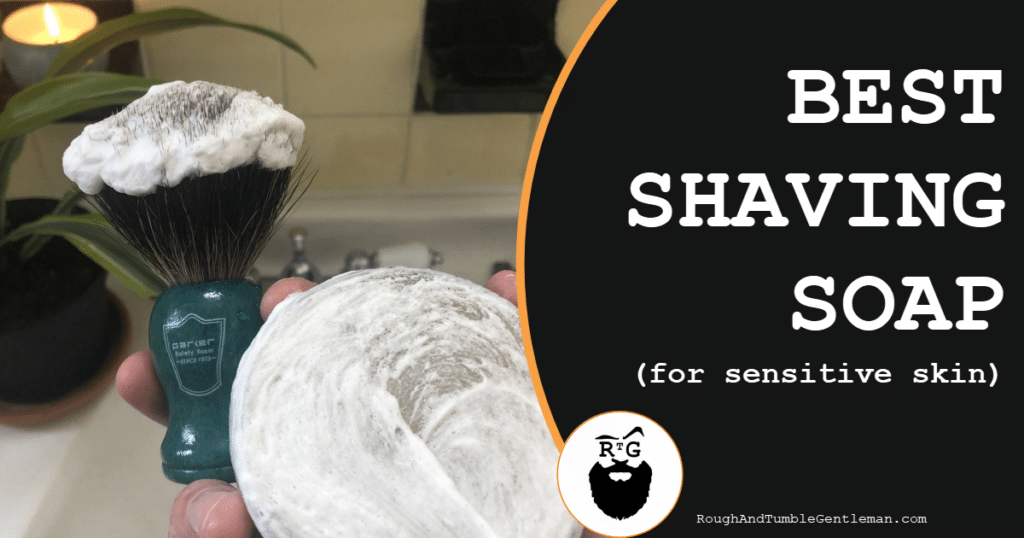Today we’ll re-visit one of the great wet shaving debates: shaving soap vs cream. Both create a full, well-cushioned lather that softens your whiskers and protects your skin, but which is empirically better?
In the article below, we’ll get to the bottom of all this. We’ll go through all the pros and cons of each, compare shaving cream vs shaving soap, come to a conclusive answer, and then I’ll share some of my favorite products.
You ready? We’ll start with…
Pros and Cons of Shaving Cream
Many men who take up wet shaving are surprised to find that traditional shaving creams are much different than “regular” creams. The first difference is the most pronounced: they never come in aerosol cans. The cream in aerosol cans almost always has a ton of weird chemicals in it, include propane, which is a gas used to push the cream out when you push the area on the top of the can. Shaving creams used for wet shaving are almost always packaged in a jar or a tube, and you manually mix them with water to produce a lather to shave with.
We’re big fans of shaving creams made specifically for wet shaving, so we’ll try to be fair and not over-hype them.
Pros of Shaving Creams
They’re Great for Men Who Are New to Wet Shaving. Wet shaving seems like it would be a simple endeavor—after all, most of us learned how to shave using disposable razors and regular shaving cream, so how hard can it be to start wet shaving? It’s basically the same thing, right?
Believe it or not, wet shaving can be a little challenging. There’s so much more equipment—soaps, creams, pre-shave oils, alum blocks, aftershave balms, and so on—and getting used to safety razors and straight razors takes a little practice. In other words, wet shaving is a skill, and it takes a little while to get the hang of it.
And that’s why shaving creams made for wet shaving are so fantastic: they’re easy to use. Put a small dollop of shaving cream on the end of your index finger, use your finger to line the inside of your bowl with it, add a couple of drops of water and stir, and wallah—you’ve got a beautiful and bright ball of shaving cream to wet shave with. It’s easy to do, and that’s an advantage—shaving soaps are a little more difficult to use, and we’ll discuss that in a moment.
They’re Reliable. There are plenty of different companies that make shaving cream, and there doesn’t seem to be much disparity between brands. They’re almost all easy to use, and they’re almost all (in our opinion) great options for beginner wet shavers. Each may result in a lather with different characteristics—some fluffier, some denser, and so on—but most are easy to whip up into a foam.
With a good shaving cream, you can “load” the brush—that is, fill it with shaving cream—very easily.
They’re Quick. With just a little bit of water and a few quick whirls of the wrist, a nice thick lather should pop up. It takes—ten, fifteen, twenty seconds?—to create a luxurious lather. That’s one of the negatives of soaps—to create a thick lather, you’re going to have work for a few minutes. We’ll talk about that soon.
They Smell Great. This, perhaps, is our favorite thing about shaving cream lathers—many are made with essential oils that smell incredible. Sandalwood is very common scent that’s used in shaving creams, and—while it’s very difficult to describe an aroma—we’ll do our best: it’s a calm, clean smell, that is somehow deep and masculine while not at all overwhelming. It smells very natural, while at the same time being something we’ve never actually smelled in nature. As we mentioned, it’s a bit difficult to explain, but it’s widely appreciated among men who are wet shave enthusiasts.
Of course, if that’s not your thing, there are plenty other scents—mostly taken from essential oils—that are available. If you’re into sweeter scents, orange blossom is very popular; if you’re looking for something more “bright,” there are lemon and lime shaving creams available; if you’re looking for something to wake up a little, there are menthol creams; and if you’re looking for something a little more “deep” and natural, cedarwood is a nice choice. And, keep in mind, if you don’t like the scents infused into many shaving creams, there are scent-free / unscented options available (and plenty of sensitive-skin options available, as well).
There are many different “pros” to creams, but scent is probably most important to us.
Next up in our shaving soap vs. cream debate:
Cons of Shaving Creams
There are three specific minuses to shaving cream:
Even Though It’s Better for Beginners, You Can Mess It Up. As we’ll discuss in a minute, working with soap to create a cushion can take some skill, and creams are almost always a better option for men new to wet shaving. That said, you can still mess things up with creams. Some men tend to over-do it on the water, and their lathers becomes runny and goopy and ineffective; others under-do it, and the lather can be a bit flat. It’s easier than soap, but it still takes a little trial-and-error.
They Tend to Disappear Quickly. In terms of last-ability, shaving cream is most definitely at a disadvantage to shaving soap. While shaving creams for wet shaving are a bit more dense in the package than they are on your face, they’re still nowhere near as densely packed as a bar of soap. If a bar of soap will allow you to create 200 lathers (and we’re using round numbers / guesstimates here—these are not figures from a study or anything), and jar of shave cream will provide you with less than half of that. That’s a loss for shaving cream, and some men simply dislike having to replace it every few months (but, keep in mind, for those guys who prefer the feel of shave cream, it’s better to replace a desired product every couple of months rather than use a longer-lasting product that they enjoy less).
It Can Be Difficult to Take on the Road. Believe it or not, the shaving creams specifically designed for wet shaving—which usually come in medium-sized jars or canisters—can be a drag to travel with. They’re a little on the large side, and not only is it difficult to fit them into travel gear, sometimes the TSA (aka the Transit Security Administration, aka the people who do security checks at airports) disallows actually them because of their size. Most shaving creams come in a jar that’s 5.0 fluid ounces or more (Taylor of Old Bond Street Sandalwood Shaving Cream is 5.3 fluid ounces, and Proraso Cream is 5.2 fluid ounces), and the TSA only allows you to carry on items of 3.4 ounces or less. There are travel sizes available—Taylor of Old Bond Street has offers a shaving cream for sensitive skin in their Jermyn Street Collection that’s only about 2.03 fluid ounces—but a lot of guys (ourselves included) are reticent to buy the same product twice. So they’re not quite perfect for traveling.
So those are the three downers to cream. But, honestly, those three cons are kind of weak sauce. The shaving creams that companies make for wet shaving are pretty rad.
Before we jump into soaps, here are a few pro-tips that relate to using creams:
Pro-Tip #1: A Little Goes a Long Way. When you’re using shaving cream that comes from cans, you need to use a glob of it that’s roughly the size of a golf ball (if you’ve got a tiny face) to a glob that’s roughly the size of a softball (if you’ve got a really large face). When you’re using high-end cream, you only need use a very small amount of it, and you’ll get a big, beautiful cushion of lather. If you use about a thimble-full of Taylor of Old Bond Street, spread it on the inside of your shaving bowl, and then add a spritz or two of water, you’ll have a big bushy ball of lather to use. And, as we’ve mentioned in other posts—go easy on the water to start. You can always add more water to the mix, but you can’t take it out.
Pro-Tip #2: Start with Cream. If you’re new to wet shaving, seriously—start with a cream, and try the soap later. It really is easier, and you’ll have a more satisfying shaving experience. A lot of us tend to have too much confidence when we jump into things, and the jump to wet shaving can be difficult, especially if you’re getting nicked a lot. It’s probably best to keep the process simple until you get the hang of things, and start with creams.

Pros and Cons of Shaving Soap
Shaving soaps look like regular bars of soap, but they’re specifically designed for shaving. Some are oval-shaped, some are bar-shaped, and some are round. Sprinkle a little water on the top of the soap, load your shaving brush with it, and mix vigorously, and you’ve got a beautiful lather to shave with.
Shaving soaps come in a hard, semi-hard, and cream varieties. Hard is the most common, but there are plenty of semi-hard options available; cream soaps (called “croaps”) are a little more rare—they’re usually stiffer than a cream, but a little more malleable than a soft soap. Cella makes a good croap, as does Proraso.
High-end bars of shaving soap are usually “triple-milled.” Milling is part of the soap-making process, wherein different ingredients in the soap are mixed together. A triple-milled soap—a soap that been put three times through the milling process—is usually denser than regular soap, and the ingredients in the soap have been more evenly dispersed throughout the soap itself. In other words, triple-milled shaving soap is a higher-quality soap, that’s easier to use and longer-lasting.
Pros of Shaving Soap
These are, according to the wet shavers we know, the biggest pros of shaving soap:
It’s Traditional. For a lot of men who are into the wet shaving, “tradition” is a big deal. It’s a very satisfying, very enjoyable thing to shave the way that your father, and your grandfather, and your grandfather’s father, all shaved. There’s something undeniably masculine about it, and learning “the old ways”—that tradition—permeates a lot of the enthusiasm around wet shaving.
And, far and away, shaving soap is the most traditional way to wet shave. It’s true! Shaving cream is relatively new—according to our research, shaving cream because a popular option around 1940—whereas bar soap has been around for millennia (if you actually read about the history of soap, it’s pretty fascinating—apparently the ancient Babylonians manufactured soap as far back as 2800 BC). That’s about 4,800 years of humans using bar soap—that’s kind of mind-boggling.
So if you’re getting into wet shaving and you’re a purist, bar soap is the way to go. Not only are there plenty of options, but many of the makers of shaving soaps have been around for centuries. Geo. F. Trumper was founded in 1875, Taylor of Old Bond Street was established in 1854, and Truefitt & Hill was founded in 1805. Think about that—that’s over two centuries of making shaving supplies for men. That’s pretty traditional.
It’s a Challenge. So, this isn’t a straight pro—it’s a pro for some guys, and a con for others. Using shave soap can be a challenge.
We mentioned earlier that shaving cream is easy to use. Add a tiny bit of water, spin your shaving brush in the bowl a few times, and a pretty white cushion of lather pops up. That’s not the case with shaving soap. Loading the brush takes some effort and building a lather takes even more effort—so if you’re new to shaving soaps, expect some sore forearms.
Not only is building a lather a challenge, but it’s also a challenge to build a lather consistently. One of the tricks of wet shaving with soap is learning to build a lather exactly as you want it. In other words, a lather that’s never to runny and never too dense. Being able to build the perfect lather time after time takes a little bit of experience.
They Last Longer. If you live in a remote area, or if you simply hate buying the same product again and again, shaving soaps are pretty fantastic. They just last. You’ll go through shaving creams pretty quickly (especially if you love the scent, and spoil yourself by using more than you need to—and, um, we’ve done that a bunch of times), but a bar of soap will most likely be a long-lasting fixture in your shaving kit. For some guys, that single pro is enough to make it part of their shaving routines.
They Travel Well. Remember above, when we said that it’s a drag to travel with shaving creams? Bars of shaving soap are a lot of easier to throw in a backpack or suitcase, AND they’re allowed in carry-on bags by the TSA (this is true at the time we posted this article, anyway). If you’re the nomadic type, shaving soap can be a great companion. And, even though we mentioned earlier that shaving soap is not made for bathing, it can double as bathing soap if you’re in a tight spot.
Cons of Shaving Soap
You’ll probably be able to guess at these. They include:
They Takes Longer to Produce a Lather. Unless you’re a morning person—and honestly, we don’t know too many of those—the minutes in your morning routine are pretty valuable, and there aren’t too many of them to spare. It really does take a longer time to build a lather using shaving soap, so if you want to make wet shaving part of your morning routine, and you don’t want to wake up any earlier than you have to, it may make more sense to stick to cream.
They Require Higher-End Brushes. There’s a wide range of quality when it comes to shaving brushes, with badger-hair brushes at the top of the list, boar’s hair brushes a step down from badger, horse hair a step down from boar’s hair, and synthetic hair one further step down from horse hair (if all that is confusing, don’t worry—we’ve written a post about shaving brushes that might help you). Many new wet shavers don’t want to invest in a badger hair brush until they’re sure they’re into wet shaving, and that means they get a brush that’s of a lower quality, and it can be very difficult to build a good lather with a lower-quality brush.
Is it impossible? No way—you can definitely do it. It’s just more of a challenge, so we’ll list that as a “con.”
They’re Not a Great Match for Hard Water. If you’ve ever showered in hard water and had a hard time getting your soap sudsy, you know what we’re getting at. Hard water has a very high mineral content, and all those minerals can make building a lather difficult. If you’ve got hard water at home, that’s another challenge of using shaving soap.
They Don’t Smell Nice! It’s not that shaving soaps smell bad, it’s that they’re typically made without the essentials oils that manufacturers include in shaving creams. So if you love that scent of sandalwood / cedar / rose / lemon / lime / bergamot / whatever, you may want to avoid soaps. In recent years, there are a couple of soaps that have been infused with scents, but those are still few and far between. Obviously, if you hate all the scents associated with shaving creams, you might consider putting this in the “pro” column.
As with creams, there really aren’t that many “cons.” The biggest con is that it can be a little difficult to use. Before we wrap, here are two pro-tips about soaps:
Pro-Tip #1: Shaving Soap and Bathing Soap Aren’t the Same Thing. Don’t use shaving soaps are regular soaps, and don’t use regular soaps as shaving soaps. We mentioned this earlier, but shaving soaps and bathing soaps are two different products, that are created for unique purposes. While you can, in fact, substitute one for the other—in a pinch, many men do so—it’s not the best idea. Shaving soap tends to dry out your skin when you bathe with it, and regular soap isn’t manufactured to create the type of lather you’ll want when wet shaving.
Pro-Tip #2: Beginner + Bar Soap + Hard Water = Difficult. At this point, we’ve mentioned a half-dozen times that shaving soap can be a challenge, but we’ll combine all that knowledge here: if you’re new to wet shaving, using bar soap, and wetting the bar with hard water, “you’re gonna have a bad time,” as they say.
Summing Up the Shaving Soap vs Cream Debate
We hate to say this, but it’s true: whatever works best for you is the best product. That’s really the heart of wet shaving: a sort of “whatever works” individualism that each man needs to figure out for himself.
If, however, you asked us our opinion about which is better, here’s how we’d boil it down.
Shaving cream is better if you:
Are new to wet shaving;
Are in a rush in the morning;
Enjoy the scents available in shaving creams; and/or
Are using hard water.
Shaving soap is better if you are:
Into the more traditional aspect of wet shaving;
Traveling and want to wet shave while you’re away; and/or
Not turned on by the scents and aromas of shavings creams.
You may be saying, “Wait! You’re forgetting the most important aspect of the debate! Which sets the stage for a closer shave—soap or cream?”
The truth is, we’ve not been able to come up with an answer for that, and we don’t think there is one. We’ve asked friends, done “unofficial” tests, and some cursory research in Badger and Blade and The Shave Den, and there doesn’t seem to be any variation in the closeness of the shave. Both shaving creams and shaving soaps do a great job of preparing your skin for your shave. Outside of the reasons we just listed, it really does come down to personal taste.
Our Favorite Soaps and Creams
It would be very rude of us to go so in-depth with soaps and creams and not share our favorite picks for soaps and creams. For shaving creams, we like:
Taylor of Old Bond Street Sandalwood Shaving Cream
Truefitt & Hill 1805 Shaving Cream
Proraso Shaving Cream
TOBS and Truefitt both come in jars, whereas the Proraso Cream comes in a tube, which makes it easy to store, if you don’t have much space in your cabinet (and wet shaving supplies DO take up a lot of room).
For shaving soaps, we like:
Henry Cavendish Himalaya Shaving Soap
Proraso Shaving Soap
Gentleman Jon Sandalwood Shave Soap
All are great options, and for whatever reason, we’ve been really into the Henry Cavendish lately.
If you’re new to wet shaving, we’d highly suggest Taylor of Old Bond Street Sandalwood Shaving Cream. It’s easy to whip into a soft cushion, and it smells fantastic.
The Debate is Over
There you have it! A conclusive, or at least semi-conclusive answer, to the question of soap vs. cream. Which is better? It depends.
This is a proud moment for us, and we’re glad that we could put the debate to rest. You’re welcome, wet shaving community!
Michael Morris is the head writer here at Rough and Tumble Gentleman. He's got a ducktail beard and loves Brazilian jiu-jitsu. He's married to the woman of his dreams and lives in Brooklyn, NY.




